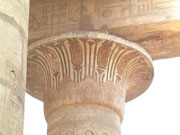TOUR NEWS - RAMESSES EGYPT OCTOBER 2009
B.C. Archaeology ran two Ramesses Egypt Tours this year due to increased interest in the program. The first program took place from the 15th October to the 5th November. The group included: Mrs Geraldine Laing, Ms Betty Elphinstone, Ms Rosanna Hindmarsh, Mrs Claire Daggett, Mr Christie Windley and Mrs Norma Windley, Ms Bronwen Shelley, Ms Roma Dix, Ms Eva Demkin, Ms Virginia Ross, Mrs Sandra Gillespie, Ms Patricia Pemberton and Mrs Mariette Merrick. The tour was led by Dr Michael Birrell and we were accompanied by our Egyptian guide Mr Mohamed Aziz.
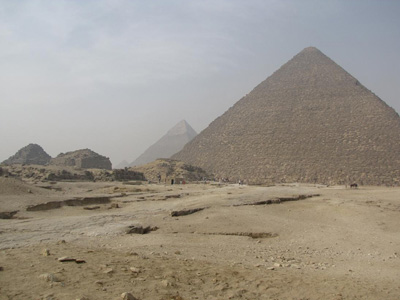 |
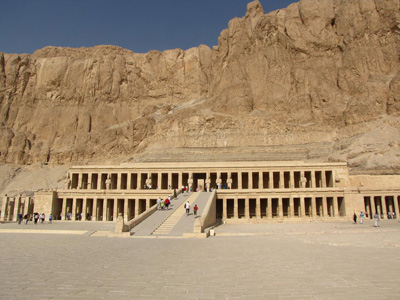 |
The Pyramids of Giza in the mist |
The splendor of Deir el Bahri |
Some members of the group asked me whether they could go a little earlier before the main tour so that they could visit Alexandria and so some of us left Australia on the 13th October. We arrived in Cairo early in the morning and caught our bus to Alexandria. The trip took us along the desert road. After lunch we visited the new Museum of Alexandria, home to a collection of sculpture and other artefacts and in the late afternoon we saw the new Library of Alexandria. We later saw a spectacular sunset from the Windsor Hotel terrace. The next morning we visited the evocative Fort Qaitbey, built on the ruins of the famous lighthouse of Alexandria and explored the remains of the Kom es-Shuqqafa Necropolis which was built in the Roman Period. The tombs are grouped around a central rotunda and are famous for their relief sculpture which includes the funerary god Anubis dressed as a Roman Centurion. In the afternoon we caught a train to Cairo and enjoyed the scenic beauty of the Delta.
In Cairo we stayed at the Golden Tulip Hotel in Zamalek, a quiet leafy part of Cairo. We met the other members of the group coming from Australia on the 16th October and went to Memphis and Saqqara to see the antiquities. This included the famous Step Pyramid of King Djoser and the painted mastaba tombs of Mereruka and Kagemni. The following morning, the 17th October, was spent at Giza where we explored the area of the Great Pyramid. It was a cool misty morning and the pyramids rose up out of the mist. We all enjoyed seeing the superb cedar boat of Khufu and then visited the pyramid of Khafre - some of the group entered the pyramid and then we explored Khafre�s impressive Valley Temple and saw the enigmatic Sphinx. We had lunch at a local restaurant and then went to the Khan el-Khalili markets to explore this mediaeval market with its maze of shops and old mosques.
Our next day took us north to the Delta ruins of Bubastis, home to the cult of the cat god Bastet. Here we saw the ruined temple of the goddess and the colossal statue of Meritamun, daughter of Ramesses. Next we headed to the famous Delta site of Tanis to see the ruins of the ancient city, passing through the scenery of the Delta. We had a pleasant picnic lunch at the site. Numerous obelisks and statues of Ramesses II were brought here from the earlier capital of Per-Ramesses and today they lay strewn around the site. A highlight of Tanis is the group of inscribed tombs for the Libyans Kings of the 22nd and 23rd Dynasties. On our return to the hotel we reached the ring road and experienced Cairo traffic at its most dramatic!
The following day was spent in the Cairo Museum with a guided tour concentrating on the New Kingdom remains. We saw the statues and reliefs and toured the treasures of Tutankhamun. Lunch took place in a nearby caf� in the refurbished Nile Hotel (the old Hilton). We saw the Tanis treasure in the afternoon and there was free time for exploring other parts of the museum�s collection.
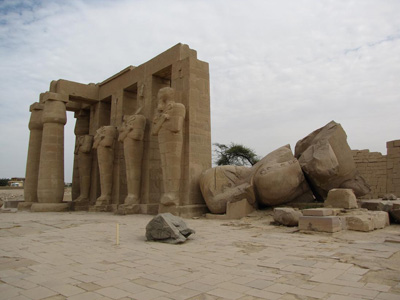 |
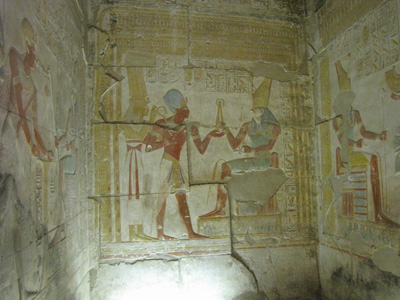 |
The colossus at the Ramesseum |
The painted chapels of Abydos |
On the 20th October we flew to Luxor. We checked into our hotel, The Nile Valley Hotel, and then visited Luxor Temple, located in the heart of the modern city. On our first full day in Luxor we saw the famous mortuary temple of Queen Hatshepsut of the 18th Dynasty. The new visitor centre at the site includes a model and short movie featuring our beloved friend Zahi Hawass (ubiquitous head of the Supreme Council of Antiquities). It was a wonderful clear morning and the temple looked magnificent. We had lunch in a local cafe before exploring the Valley of the Kings. Here we saw three of the royal tombs of the New Kingdom, including the tomb of Horemhab which has been closed for many years.
On the 22nd October we visited Deir el-Medina, the ancient village of the workmen who fashioned the royal tombs in the Valley of the Kings. We explored the village and descended into two superb painted tombs. We then saw a number of the painted tombs belonging to high officials of the New Kingdom in the so-called �Valley of the Nobles�. We had lunch in the Ramesseum Caf� near Medinet Habu and then spent the rest of the afternoon at the romantic ruins of the Ramesseum.
The following day was our free day in Luxor. Most of us went over to the Winter palace Hotel on the other side of the river for a fancy breakfast. We enjoyed a walk through the manicured gardens and saw a pair of hoopoe birds which always signal a day of good luck. On the 24th October we went north from Luxor by bus to see the mortuary temples of Sety I and Ramesses II at Abydos. These superb painted temples contain beautiful wall reliefs and the famous king list. We also walked across the desert to the Osireon, the mythological tomb of Osiris which was built by Sety I, and explored the small Temple of Ramesses II. After a picnic lunch we headed back to Luxor, stopping en route to see the impressive Ptolemaic Temple of Hathor at Dendera and wander around the ruins. The restoration of the painted scenes on the ceiling of the pronaos is really coming along! The following morning we took a motorboat up to Karnak Temple, enjoying the early morning on the river. We stopped at the new visitor centre and then spent the morning looking at the forecourt and Hypostyle Hall of Karnak, before wandering around the impressive shrine. It was relatively quiet in the Hypostyle Hall which makes a change. In the afternoon we went for our felucca sailboat ride on the Nile - the wind dropped down completely and we were only saved from a night on the river when Bronwen and Mim (with a little help from the Egyptian boatmen) rowed us back to the shore!
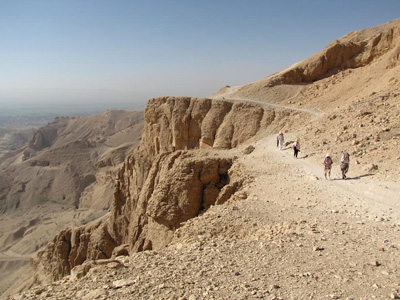 |
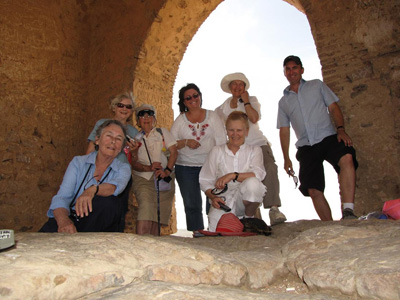 |
Our walk across the Theban Hills |
Exploring the Dome of the Winds at Aswan |
Our last morning in Luxor, the 26th October, began with a walk over the Theban Hills. We started at Deir el-Medina and walked across to the Valley of the Kings, descending near Deir el-Bahri. A cool crisp morning gave us panoramic views. After that we made our visit to the temple of Medinet Habu, the magnificent mortuary temple of Ramesses III which still preserves its superb war reliefs and coloured scenes of religious processions. In the afternoon we saw three tombs in the Valley of the Queens. That evening we enjoyed the dancing and music show at our hotel and Rosanna and Bronwen showed us all their belly dancing skills.
The following day we left for our early morning bus ride south of Luxor to Aswan. En route we made two stops - the first was to see the superb Ptolemaic temple of Horus at Edfu which is so well preserved that you can imagine that the temple is still being used. From there we continued on to the Ptolemaic Temple of Sobek and Horus at Kom Ombo, where the River Nile provides a dramatic back drop to the ruins. In Aswan we had a rest and then had afternoon tea at sunset overlooking the Nile from the Nubian House restaurant.
Wednesday the 28th October was spent visiting the painted tombs of the Old Kingdom governors of Aswan. We reached the cemetery by felucca sailboat and climbed the stairs to the tombs. The view across the Nile was magnificent and some of us made it to the Qubbet el-Hawa, the Dome of the Winds, on the summit of the hill. In the afternoon we sailed our boat to Kitchener�s Island where we tour the botanical gardens of Aswan, dedicated to the propagation of palm species. We then had a late lunch at a restaurant with a superb view of the Nile.
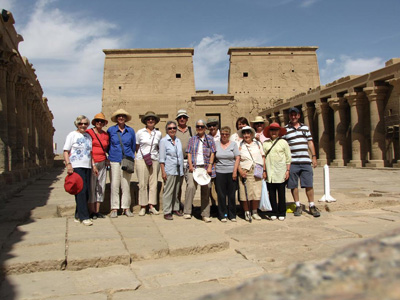 |
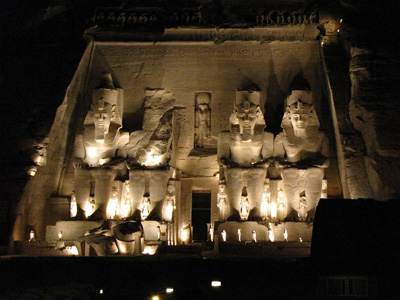 |
The October group at Philae Temple |
Abu Simbel at night - magical! |
We next visited the fascinating granite quarries of Aswan and saw the remarkable unfinished obelisk which is still embedded in the rock. We then went to see the Aswan High Dam, a marvel of modern engineering which was built to control the flooding of the Nile. In the afternoon we visited the beautiful ruins of Philae Island, cult place of Isis, said by many to be Egypt�s most beautiful temple. We had a picnic on the island and toured the temple, with a lighthearted exam to see who could remember their Egyptian gods. Everyone passed!
On the 30th October we headed by bus across the beautiful Nubian Desert to Abu Simbel, the magnificent Nubian temples of Ramesses II. The stark desert landscape includes numerous natural pyramids and open areas of drift sand. We checked into our cruise boat (the Nubian Sea), had some lunch and then went to explore the temples of Abu Simbel. We had plenty of time to wander around the temples and everyone enjoyed seeing the �Sound and Light Show� in the evening.
We departed Abu Simbel for our cruise on Lake Nasser early the next morning, enjoying the sight of the temples illuminated by the rising sun. There was time to relax and read and watch the passing of the desolate Nubian landscape. During the day we stopped to look at Kasr Ibrim and went ashore to tour the romantic desert Temples of Amada (18th Dynasty) and Derr (Ramesses the Great). Both temples were moved during the construction of the Aswan Dam and their preservation is a credit to the international rescue effort.
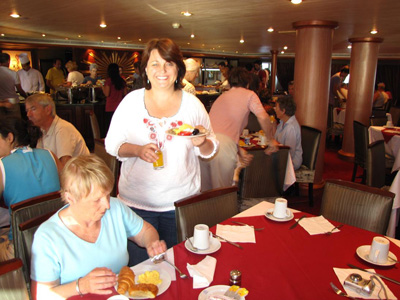 |
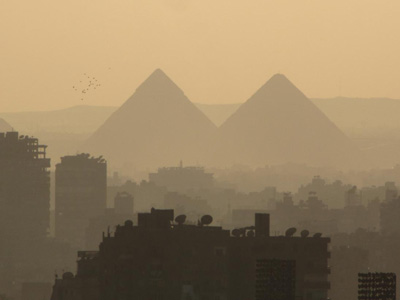 |
Relaxing on the Lake Nasser cruise |
Sunset behind the pyramids |
The following morning, the 1st November, we visited the picturesque temple of Wadi es-Sebua, constructed by Ramesses the Great. The decoration of the rockcut chapel is remarkably well preserved. Many of us took a camel ride across the vast desert landscape to the Temple of Dakka (Ptolemaic Period) and we also saw the Roman shrine of Maharakka. In the evening we were entertained on board by Nubian dancers.
The following day we left the boat and saw the beautiful painted rock-cut temple of Ramesses II at Beit el-Wali, moved from its original location to the region beside the Aswan High Dam. The temple retains a number of fine painted relief scenes. We also explored the impressive Roman Period temple of Kalabsha, dedicated to the Nubian god Mandulis, and enjoyed the picturesque Kiosk of Qirtassi, re-erected with a view over Lake Nasser. That afternoon we went to see the Nubian Museum and had afternoon tea with a view over the Nile from the terrace of the Nubian House restaurant. In the evening we headed to Aswan airport for our flight to Cairo.
The last day of touring was spent in mediaeval Cairo. After lunch in the Al-Azhar Park pavilion we toured some of the Old City of Cairo and saw the awe inspiring buildings of the Islamic Period. A high-light was the monumental 19th Century Mosque of Mohamed Ali in the Citadel of Saladin. Aziz gave us an interesting talk about Islam and what it is like to be a Muslim. In the evening we went to the Marriot Hotel nearby in Zamalek - this was a 19th Century palace used during the opening of the Suez Canal. It preserves the feel of a bygone age with its grand ball rooms and reception.
The following morning we headed off to Cairo International Airport for our flight back to Australia. The group really seemed to enjoy themselves on the program and showed interest in everything we saw. It was a pleasure to travel with them!
Michael Birrell
